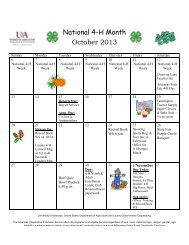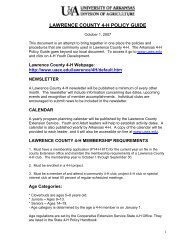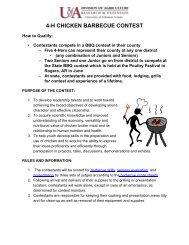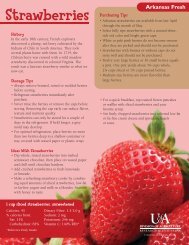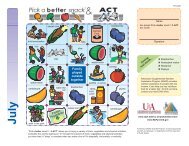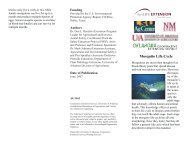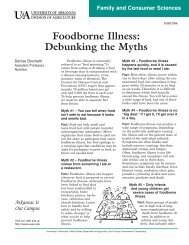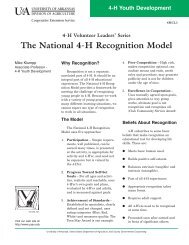Strength Training With Stretch Tubes - University of Arkansas ...
Strength Training With Stretch Tubes - University of Arkansas ...
Strength Training With Stretch Tubes - University of Arkansas ...
Create successful ePaper yourself
Turn your PDF publications into a flip-book with our unique Google optimized e-Paper software.
Family and Consumer Sciences<br />
Increasing Physical Activity As We Age<br />
<strong>Strength</strong> <strong>Training</strong> <br />
<strong>With</strong> <strong>Stretch</strong> <strong>Tubes</strong><br />
FSFCS36<br />
LaVona Traywick, Ph.D.<br />
Assistant Pr<strong>of</strong>essor <br />
Gerontology<br />
Teresa Henson<br />
EFNEP Technician<br />
Susan Pickle<br />
County Extension Agent <br />
Family and Consumer<br />
Sciences<br />
<strong>Arkansas</strong> Is<br />
Our Campus<br />
Visit our web site at:<br />
http://www.uaex.edu<br />
The goal <strong>of</strong> strength<br />
training is to grow stronger.<br />
<strong>Strength</strong> training takes place<br />
when we work the skeletal<br />
muscles <strong>of</strong> our bodies harder<br />
than they are used to. <strong>Strength</strong><br />
training increases strength,<br />
aerobic endurance and<br />
muscle mass.<br />
Sarcopenia is the technical<br />
term researchers have given to<br />
describe loss <strong>of</strong> muscle,<br />
strength and quality <strong>of</strong> muscle<br />
tissue. Sarcopenia is <strong>of</strong>ten seen<br />
in older adults. Some experts<br />
have suggested that muscle<br />
mass declines about 1 percent<br />
each year beginning at about<br />
age 30. Although there are still<br />
many questions remaining<br />
about muscle loss and aging, we<br />
know that muscle-building<br />
exercises can improve strength<br />
in most older adults while a<br />
sedentary lifestyle contributes<br />
to muscle loss. To keep from<br />
losing muscle mass, the recommendations<br />
are to do strengthening<br />
exercises for all <strong>of</strong> your<br />
major muscle groups at least<br />
twice a week; however, do not<br />
do strength-training exercises<br />
<strong>of</strong> the same muscle group on<br />
any two days in a row.<br />
Most people think <strong>of</strong><br />
strength training as lifting free<br />
weights (such as barbells and<br />
dumbbells). This is called<br />
isotonic strength training –<br />
contractions in which a muscle<br />
shortens against a constant<br />
load or tension resulting in<br />
movement – but there are many<br />
ways to strength train. Isometric<br />
strength training – sometimes<br />
referred to as “static” – is<br />
where the muscle develops<br />
tension but does not shorten.<br />
Attempting to pick up the chair<br />
you are sitting in or standing<br />
with each hand on opposite<br />
sides <strong>of</strong> a doorway attempting<br />
to push down the wall are<br />
examples <strong>of</strong> isometric strength<br />
training. But even with isotonic<br />
strength training, there are<br />
other options besides free<br />
weights. You can use your own<br />
body weight for resistance, such<br />
as in push-ups, or other<br />
variable-resistance fitness<br />
equipment, such as stretch<br />
bands and exercise tubes.<br />
Resistance Bands<br />
Versus Resistance <strong>Tubes</strong><br />
The terms resistance<br />
bands and resistance tubes<br />
are <strong>of</strong>ten used interchangeably.<br />
<strong>University</strong> <strong>of</strong> <strong>Arkansas</strong>, United States Department <strong>of</strong> Agriculture, and County Governments Cooperating
They both can substitute for free weights or<br />
machines to help you build muscle strength<br />
and bone density. Both resistance bands and<br />
tubes are color-coded based on the level <strong>of</strong><br />
resistance. However, there is not an industry<br />
standard on colors, and all companies label<br />
and color code their bands differently. Both<br />
are used in the same way, the difference is in<br />
their shape.<br />
Resistance bands (sometimes called flat<br />
bands or stretch bands) are stretchy elastic<br />
bands that range in width from 2 to 6 inches.<br />
Resistance bands<br />
can be bought on<br />
a roll and cut to<br />
your preferred<br />
length, but you<br />
will most likely<br />
buy them precut.<br />
Precut lengths<br />
usually run from<br />
3 to 6 feet. The<br />
level <strong>of</strong> “resis-<br />
Resistance<br />
bands in rolls<br />
Resistance band precut<br />
tance” <strong>of</strong>fered in<br />
the bands ranges from extra-light to extraheavy.<br />
Many contain latex, so be sure to<br />
check the packaging for latex-free if you<br />
have an allergy.<br />
Exercise resistance tubing (sometimes<br />
called resistance bands, exercise bands, fit<br />
tubes, exercise tubes or other similar names)<br />
consists <strong>of</strong> elastic tubes with handles. The<br />
design is simply a long,<br />
plastic or rubber tube<br />
that is hollow inside and<br />
made <strong>of</strong> a very sturdy,<br />
yet somewhat pliable Resistance tube<br />
material. The tubes<br />
come in various thicknesses to increase the<br />
tension. The handles are usually in a<br />
triangular shape and can be hard plastic or<br />
padded. Although resistance tubes also come<br />
in a variety <strong>of</strong> resistance levels, the elastic<br />
properties <strong>of</strong> the tubing gives varying levels<br />
<strong>of</strong> intensity with the same tube.<br />
Why Use Resistance <strong>Tubes</strong>?<br />
Resistance tubes <strong>of</strong>fer numerous<br />
exercise options. The resistance tube can be<br />
used by itself, with a partner or with an<br />
anchor to add additional exercise options.<br />
Whether being used for adding muscle tone,<br />
muscle strength, burning fat or simply<br />
increasing flexibility, resistance tubes are a<br />
very easy way to add something different to<br />
your daily exercise routine or to start a<br />
workout routine.<br />
There are many advantages to using<br />
resistance tubes:<br />
• They are very effective in strength<br />
training exercises.<br />
• They can be used almost anywhere:<br />
home, <strong>of</strong>fice and outdoors.<br />
• They are portable and storable: they<br />
take up little space and are lighter<br />
than free weights.<br />
• They are more affordable than free<br />
weights.<br />
• They are durable.<br />
• They are versatile.<br />
• They are relatively safe.<br />
There are, however, some disadvantages<br />
to using resistance bands as compared to<br />
free weights. It’s almost impossible to know<br />
precisely how much weight you are lifting in<br />
contrast to free weights. As they age, resistance<br />
bands lose some <strong>of</strong> their elasticity. If<br />
the bands are rubbed against a sharp object,<br />
they may snap. There is not as much<br />
research to back their effectiveness<br />
compared to free weights.<br />
Tips for Buying Resistance <strong>Tubes</strong><br />
Resistance tubes should be bought based<br />
on a few different criteria: how much resistance<br />
they give, how long they are and, <strong>of</strong><br />
course, what sort <strong>of</strong> handles they have.<br />
Selection Criteria for Resistance <strong>Tubes</strong><br />
Resistance Level<br />
Length<br />
Choice <strong>of</strong> Handle
Other tips for buying resistance tubes<br />
include:<br />
• Buy a variety <strong>of</strong> tubes. It’s best to<br />
have at least three – light, medium<br />
and heavy – since different muscle<br />
groups will require different levels<br />
<strong>of</strong> resistance.<br />
• Buy comfortable, easy-to-use<br />
tubes. Some tubes you find in stores<br />
<strong>of</strong>fer interchangeable handles<br />
(which means you have to take<br />
them <strong>of</strong>f and on to use different<br />
tubes), and some have handles that<br />
are larger than normal or made <strong>of</strong><br />
hard plastic.<br />
• Buy accessories. One key to using<br />
tubes is having different ways to<br />
attach them. Examples <strong>of</strong> accessories<br />
include door attachments,<br />
ankle cuffs and different handles.<br />
• Keep it simple. As with the accessories,<br />
there are multiple options<br />
when it comes to the tubes<br />
themselves. Examples include<br />
figure 8s, double bands and circular<br />
bands. When you first start tubing,<br />
stick with the basic long tube with<br />
handles. You may want to buy other<br />
types later for variety.<br />
• Maintain good posture throughout<br />
each exercise: Keep your knees<br />
slightly bent, your abdominal<br />
muscles pulled in and your chest<br />
expanded.<br />
• Perform the exercises in a slow and<br />
controlled manner, to work against<br />
resistance both when you pull on<br />
the tube and when you return to the<br />
starting position.<br />
Using Resistance <strong>Tubes</strong><br />
and Bands<br />
Before you can begin to exercise with<br />
stretch bands or resistance tubes, you first<br />
need to know how to hold them.<br />
Hand Holds<br />
To hold a stretch band:<br />
1. Lay the band flat in your hand with<br />
the end toward your pinky finger.<br />
2. Wrap the long end <strong>of</strong> the band<br />
around the back <strong>of</strong> your hand.<br />
3. Grasp firmly.<br />
Resistance Tubing Safety Tips<br />
As with all forms <strong>of</strong> exercise, there is<br />
some risk <strong>of</strong> injury. Use the following tips to<br />
help keep you safe while you work out:<br />
• Check for holes or worn spots in the<br />
tubing. Replace the tube if you see<br />
any tears.<br />
• Do your workout on carpeting, wood<br />
floors or grass. Abrasive surfaces,<br />
such as asphalt or cement, can tear<br />
your tube.<br />
• Wear comfortable, supportive,<br />
closed-toed athletic shoes.<br />
• Make sure the tubing is secured<br />
underfoot or on an anchor before<br />
you begin each exercise.<br />
• Make sure you have a secure grip<br />
on the handle before you begin<br />
an exercise.<br />
Wrapping a resistance band<br />
Resistance tubes differ from stretch<br />
bands in several ways – one <strong>of</strong> which is that<br />
they have handles. Be sure to hold on to the<br />
handle so it does not slip out <strong>of</strong> your hand.<br />
Standard Hold –<br />
Grasp the handle with a<br />
firm grip. Four fingers<br />
wrap around one side,<br />
and the thumb comes<br />
across from the other.<br />
Resist the temptation<br />
to excessively squeeze<br />
the handle.
Choke Hold – In<br />
some instances, the<br />
stretch tube may be too<br />
long to properly perform<br />
the exercise. When this<br />
occurs, simply loop the<br />
tube around and lay it<br />
beside the handle. Grasp<br />
both the handle and the<br />
tube together.<br />
Foot Holds<br />
When performing exercises using the<br />
feet as the anchor point for the stretch tube,<br />
it is very important that the tube does not<br />
slip out from under your feet. This could<br />
cause the tube to snap up like a rubber band<br />
and possibly hit you.<br />
The way you stand on the stretch tube<br />
will affect the tension in the tube. Typically,<br />
an exercise will call for you to step in the<br />
middle <strong>of</strong> the tube with feet hip width apart.<br />
Only standing with one foot <strong>of</strong>fers the least<br />
resistance, while standing with feet further<br />
Shoulders<br />
Overhead Press<br />
1. Step on the tube with both feet (or one<br />
foot if needed) and knees slightly bent.<br />
Curl your palms towards your shoulders,<br />
then rotate them to the front –<br />
palms facing forward and raise your<br />
elbows to a 90 degree bend.<br />
2. Press your arms overhead until your<br />
elbows are straight, keeping your shoulders<br />
pulled down away from your ears.<br />
3. Lower your elbows until hands are at<br />
shoulder height. Repeat.<br />
Front Lateral Raise<br />
1. Step on the tube with both feet. Hold<br />
the handles with your palms facing<br />
back, thumbs rotated slightly forward.<br />
Pull your shoulders back and down.<br />
2. Raise both arms directly in front <strong>of</strong> your<br />
shoulders with your arms straight. (May<br />
do one arm at a time.)<br />
3. Lower arms to starting position. Repeat.<br />
than hip width apart, a wide stance, <strong>of</strong>fers<br />
more <strong>of</strong> a challenge.<br />
One foot<br />
Exercise Routine<br />
Two feet<br />
Sometimes an exercise<br />
with a stretch tube will ask<br />
you to place the tube<br />
around your ankle. There<br />
are accessories available,<br />
but if you have<br />
not bought an<br />
ankle cuff, you<br />
can simply<br />
thread one end<br />
<strong>of</strong> the resistance<br />
tube<br />
Threading one<br />
handle through<br />
the other<br />
Wide stance<br />
Ankle cuff<br />
Placing foot<br />
through loop<br />
through the<br />
handle <strong>of</strong> the<br />
other end to make a loop. Place this loop<br />
around your ankle and pull tight.
Up-Right Row<br />
1. Step on the tube with both feet holding<br />
the handles with your palms facing<br />
your legs. Rotate your thumbs slightly<br />
forward.<br />
2. Lean slightly forward to enable your<br />
arms to be vertical during the exercise.<br />
Raise your elbows towards the ceiling<br />
keeping your wrists in a neutral<br />
position. Pause when your elbows are<br />
slightly above shoulder height. Elbows<br />
are also above hand height.<br />
3. Lower arms back to starting position.<br />
Repeat.<br />
Arms<br />
Biceps Curl<br />
1. Step on the tube with both feet and<br />
knees slightly bent. Rotate your palms<br />
outward so that your thumbs face away<br />
from each other.<br />
2. Pull your hands towards your shoulders,<br />
stopping when your hands are approximately<br />
a fist’s distance away from<br />
your shoulders.<br />
3. Lower your arms slowly to the starting<br />
position keeping your elbows still.<br />
Repeat.<br />
Triceps Kickback<br />
1. Step on the tube with one foot. Step<br />
back about 2 feet with the opposite foot.<br />
Keep your knees bent.<br />
2. Bend forward with a neutral spine.<br />
<strong>With</strong> one arm at a time, using the arm<br />
on the same side <strong>of</strong> your body as the<br />
foot holding the tube, put your elbow at<br />
your waist. Keep your upper arm<br />
stationary as you extend your lower arm<br />
until your elbow is straight.<br />
3. Return your elbow to a 90 degree bend.<br />
Repeat.<br />
4. Repeat the exercise with the opposite<br />
arm holding the tube with the<br />
opposite foot.
Wrist Curl<br />
1. While sitting in a chair, step both feet<br />
on the tube with one handle in each<br />
hand. Lean forward slightly so that the<br />
backs <strong>of</strong> your forearms are resting on<br />
your thighs, palms up.<br />
2. Curl your knuckles back towards<br />
your elbow while keeping your arm<br />
stationary on your legs.<br />
3. Lower and repeat.<br />
(This exercise can be performed while<br />
standing. Place both feet on tube. Bend your<br />
elbows to 90 degrees, palms up. Curl your<br />
knuckles towards your elbows without<br />
moving the rest <strong>of</strong> your arm. Lower your<br />
wrists slightly lower than your arms’ height.<br />
Repeat.)<br />
Legs<br />
Leg Press<br />
1. Sit upright in a chair. Wrap the tube<br />
around one foot and hold a handle in<br />
each hand. Leave the foot without the<br />
tube placed flat on the floor. Hold your<br />
arms at a 90 degree angle at your waist,<br />
palms facing each other.<br />
2. Bring the knee <strong>of</strong> the foot with the tube<br />
up towards your chest.<br />
3. Press your leg forward in a natural alignment<br />
while keeping the tube handles<br />
tight with your arms at your side.<br />
4. Bring the knee back up towards your<br />
chest and repeat.<br />
5. Repeat the exercise with the opposite leg.<br />
Calf Raises<br />
1. Step on the tube with both feet, making<br />
sure the tube is under the ball <strong>of</strong> your<br />
foot. Hold one handle in each hand.<br />
2. Raise up on the balls <strong>of</strong> your feet, like<br />
you are standing on your tiptoes. Pull<br />
the tube with you to create extra<br />
resistance.<br />
3. Lower your heels slowly to the floor.<br />
Repeat.
Side Hip Raise<br />
1. Thread the handle <strong>of</strong> one end <strong>of</strong> the<br />
tube through the handle <strong>of</strong> other end to<br />
make a loop. Place your right foot<br />
through the loop and secure slightly<br />
above your ankle.<br />
2. Step on the tube with the left foot and<br />
hold the free handle in your left hand.<br />
3. Stand tall as you shift your weight to<br />
your left leg. Raise your right leg 6 to<br />
8 inches <strong>of</strong>f the floor, toes facing forward.<br />
4. Resist the pull as you slowly lower the<br />
right leg back towards the floor. Repeat.<br />
5. Change the loop from the right leg to the<br />
left leg and repeat on the opposite side.<br />
Chest<br />
Chest Press<br />
1. Place the tube around your back just<br />
slightly under your armpits. Place one<br />
handle in each hand.<br />
2. Bring your arms up to chest level with<br />
elbows bent at a 90 degree angle, parallel<br />
to the floor, with palms facing down.<br />
(You may need to “Choke Hold.”)<br />
3. Press the handles forward, palms down,<br />
until your arms are straight.<br />
4. Bend your elbows back to a 90 degree<br />
angle while keeping the arms parallel to<br />
the floor. Repeat.<br />
Chest Fly<br />
1. Place the tube around your back just<br />
slightly under your armpits. Place one<br />
handle in each hand.<br />
2. Bring your arms out to your side,<br />
parallel to the floor with palms facing<br />
forward.<br />
3. While keeping your elbows slightly lower<br />
than your shoulders, bring your hands<br />
towards each other without bending at<br />
the elbow. Try to maintain a slightly<br />
rounded arm position as you close your<br />
arms towards each other. Pause.<br />
4. Open your arms until your elbows are<br />
even with your shoulders. Repeat.
Back<br />
Seated Row<br />
1. Sit in a sturdy chair. Wrap the tube<br />
around both feet and hold the handles<br />
with your thumbs up and with slight<br />
tension in the tube. (You may need to use<br />
the “Choke Hold.”) Legs are stretched<br />
out in front, resting on your heels, flex<br />
your feet.<br />
2. Pull your shoulders back bringing the<br />
handles back as far as you can without<br />
moving your torso.<br />
3. Return to straight arms and repeat.<br />
Dead Lift<br />
1. Step on the middle <strong>of</strong> the tube with both<br />
feet. Start with a fair amount <strong>of</strong> tension in<br />
the tube. (May need to “Choke Hold” the<br />
tube or widen your stance with your feet.)<br />
2. Stand upright and tuck your hips<br />
under you.<br />
3. Bend at the waist until you reach a table<br />
top position, body parallel to the ground.<br />
4. Slowly raise to standing position. Repeat.<br />
References<br />
Photos<br />
• eMedicine Health (2010)<br />
(http://www.emedicinehealth.com<br />
• 2008 Physical Activity Guidelines /strength_training/page8_em.htm) Acknowledgment<br />
for Americans: Be Active, Healthy, • Exercise Description Help (2010)<br />
and Happy! (2008), Washington, D.C.: (http://www.fitlink.com)<br />
• Kerry Rodtnick, Extension<br />
U.S. Department <strong>of</strong> Health and<br />
Videographer, Communications,<br />
• Exercise and Physical Activity:<br />
Human Services, Government<br />
U <strong>of</strong> A Division <strong>of</strong> Agriculture,<br />
Your Guide From the National<br />
Printing Office. ODPHP Publication<br />
Little Rock<br />
Institute on Aging (2009). National<br />
No. U0036<br />
Institute on Aging and the National • Fitness Wholesale Online<br />
• “American College <strong>of</strong> Sports<br />
Institutes <strong>of</strong> Health. Government (http://www.fwonline.com/)<br />
Medicine Position Stand. Exercise Printing Office. Publication • Exercise and Physical Activity:<br />
and Physical Activity for Older No. 09-4258 Your Guide From the National<br />
Adults” (1998). Med Sci Sports<br />
• Fitness for Travelers: The Ultimate Institute on Aging (2009). National<br />
Exerc, 30(6), 992-1008<br />
Workout Guide for the Road<br />
Institute on Aging and the<br />
• Buying Resistance Bands by Paige (Houghton Mifflin, 2002) by<br />
National Institutes <strong>of</strong> Health.<br />
Waehner, About.com Guide (2009) Suzanne Schlosberg<br />
Government Printing Office.<br />
(http://exercise.about.com/cs<br />
Publication No. 09-4258, Page 44<br />
• Resistance Bands Benefits vs. Free<br />
/exerciseworkouts/a/resistance_2.htm)<br />
(Wrapping a Resistance Band)<br />
Weights Benefits (2010)<br />
• Centers for Disease Control and (http://www.how-to-exercise.com)<br />
Prevention: Physical Activity (2010)<br />
• Resistance <strong>Tubes</strong> by Sam Jones (2010)<br />
(http://www.cdc.gov/physicalactivity<br />
(http://www.resistancetubes.net)<br />
/index.html)<br />
Printed by <strong>University</strong> <strong>of</strong> <strong>Arkansas</strong> Cooperative Extension Service Printing Services.<br />
Issued in furtherance <strong>of</strong> Cooperative Extension work, Acts <strong>of</strong> May 8 and<br />
June 30, 1914, in cooperation with the U.S. Department <strong>of</strong> Agriculture,<br />
Director, Cooperative Extension Service, <strong>University</strong> <strong>of</strong> <strong>Arkansas</strong>. The<br />
<strong>Arkansas</strong> Cooperative Extension Service <strong>of</strong>fers its programs to all eligi<br />
ble persons regardless <strong>of</strong> race, color, national origin, religion, gender,<br />
age, disability, marital or veteran status, or any other legally protected<br />
status, and is an Affirmative Action/Equal Opportunity Employer.<br />
LAVONA TRAYWICK, Ph.D., is assistant pr<strong>of</strong>essor - gerontology and<br />
TERESA HENSON is EFNEP technician located in the Little Rock<br />
State Office. SUSAN PICKLE is county Extension agent - family and<br />
consumer sciences, Benton County. They are employees <strong>of</strong> the <strong>University</strong><br />
<strong>of</strong> <strong>Arkansas</strong> Division <strong>of</strong> Agriculture.<br />
FSFCS36-PD-11-10N




